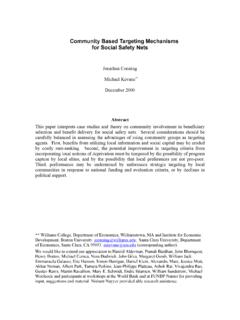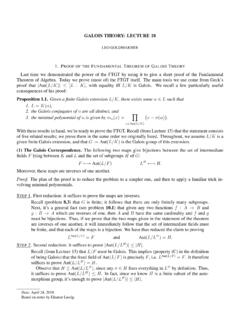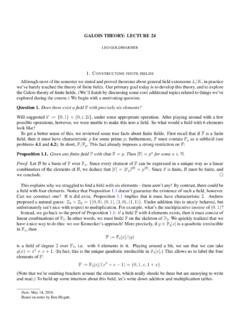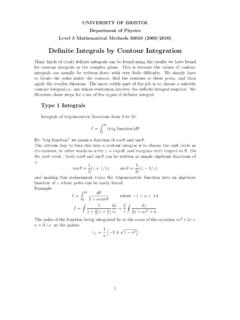Transcription of Experiment 2-3 Qualitative Analysis of Metal Ions in Solution
1 II & III-1 Experiment 2-3 Qualitative Analysis of Metal Ions in SolutionIntroductionIt is extremely useful to know how to detect the presence of specific ions in an aqueoussolution. This type of Analysis falls under the general category of analytical chemistry calledqualitative Analysis , which addresses the question "What is in a sample?" The basis for aqualitative Analysis is the fact that ions will undergo specific chemical reactions with certainreagents to yield observable products. For example, silver ion can be precipitated withhydrochloric acid to yield solid silver chloride.
2 Because many cations will not react withhydrochloric acid in this way, this simple reaction can be used to separate ions that forminsoluble chlorides from those that do not. In fact, the Qualitative detection of ions in a mixtureis commonly accomplished by a system of Analysis in which precipitation reactions play a majorrole. In addition, acid-base reactions, oxidation-reduction reactions, and the formation ofcomplex ions are often used in a systematic way for either separating ions or for determining thepresence of specific Qualitative Analysis of ions in a mixture must follow a scheme that can besummarized as follows: (1) Add reagents that exploit the more general properties of ions toseparate major groups of ions; (2) separate major groups into subgroups with reactions that willdistinguish less general properties.
3 And (3) add reagents that will specifically confirm thepresence of individual ions. Following this general three-step plan, several different analyticalschemes have been devised that are based on various ways of defining major groups. In thiscourse, you will follow a scheme which separates cations into five major groups according to thesolubilities of their compounds:Group I (Ag+, Pb2+, Hg2+) cations produce insoluble chlorides so they can be precipitated withdilute HCl, while all other cations remain in II (Cu2+, Bi3+, Cd2+, Hg2+, As3+, Sb3+, Sn4+) cations produce very insoluble sulfides(Ksp values less than 10-30) so they can be precipitated by low amounts of sulfide ion.
4 This can beachieved by adding an acidic Solution of III (Al3+, Cr3+, Fe3+, Zn2+, Ni2+, Co2+, Mn2+) cations produce slightly soluble sulfides(Ksp values more than 10-20) so they can be precipitated by relatively high amounts of sulfide ion;this can be achieved by adding a basic Solution of IV (Mg2+, Ca2+, Sr2+, Ba2+) cations, as well as all of the above groups, produceinsoluble carbonates so they can be precipitated by the addition of carbonate once the ions of thefirst three groups have been V (Na+, K+, NH4+) cations do not precipitate with any of the above a successful Qualitative Analysis based on the above five groups, the order of reagentaddition is crucial and should follow the order listed above (that is, group I first, group II second,and so on).
5 For example, addition of carbonate first would precipitate everything but the groupV ions or addition of basic H2S first would precipitate all group II and group III much of Qualitative Analysis involves selective precipitation and then separation ofthe two phases, it is convenient to represent an analytical scheme in the form of a flow chart. Forexample, a simple flow chart is shown below for separating a known mixture of Ag+(group I),Cu2+(group II), and Ca2+ (group IV) ions. The addition of each reagent (presented in order fromtop to bottom) produces a solid phase and an aqueous phase that can be separated by centrifugationor & I11-2 AgCl(s)dilute HCl(aq)acidic H2S(aq)CuS(s)Cu2+(aq), Ca2+(aq)Ca2+(aq)Ag+(aq), Cu2+(aq), Ca2+(aq)NH4CO3(aq)CaCO3(s)The above flow chart translates to the following steps: (1) add dilute HCl to precipitate AgClfrom the mixture; (2) centrifuge sample to yield a solid pellet of AgCl and a supernatant (thesolution that remains above the pellet after centrifugation).
6 (3) remove the supernatant and add toit acidic H2S to precipitate CuS; (4) centrifuge; (5) remove supernatant and add to itNH4CO3(aq) to precipitate CaCO3. Of course, this is a simplified scheme for the purpose ofexample; if you were to analyze an unknown mixture you would need to include: steps to checkfor the presence of any group III or group V ions; several steps to separate major groups intosubgroups; and then confirmatory tests for the presence of each individual you have separated a mixture into major groups a variety of reagents can be addedto distinguish subgroups or individual ions.
7 These reagents are chosen because they react withspecific ions to exploit less general properties (reactions can involve precipitation, acid-baseneutralization, oxidation-reduction, or complex ion formation). In the same way that a flowchart can be used to describe the separation of major groups, you can construct flow charts forthe separation of components within a major any Qualitative Analysis it is important to run your analytical scheme on "known"samples, prepared to contain specific ions of interest, as well as "unknown" samples in order totest your ability to use the procedure to analyze a Solution of unknown composition.
8 In this way,you can observe first-hand how a particular ion behaves when a certain reagent is added andmake comparisons with the behavior of your unknown & I11-3 The primary objectives of this Experiment are to learn how to: observe and record carefully the chemical behavior of ions with different reagents. learn how to apply fundamental chemical principles to an experimental situation. learn how to evaluate critically experimental InstructionsThe various reagents that you will need are either in "qual blocks" in the center of eachbench, or in the hoods (solutions to be analyzed, strong bases, ammonium thiocynate) at the sidesof the room.
9 Be careful using the automatic burets and dispensers. You will work with three known solutions, and one unknown. Given the toxicity of the ions, all waste should bediscarded in the appropriate waste container in the notebook records should be kept of all tests on knowns and unknowns. Results inqualitative Analysis are easily confused, and it is therefore very important that you be diligentabout labeling your various test tubes, and that you record your observations immediately. It issuggested that you use the following format for your lab crystalswhite pptions of Group pptfrom step 1hot H2 Oppt completelydissolvesPb2+ probably presentAg+,Hg2+2 fromstep 2CH3 COOHK2 CrO4yellow pptPb2+ presentGeneral techniques in semimicro Qualitative analysis1.
10 After adding a reagent, stir the Solution thoroughly before drawing any final should be done whether the reaction is carried out in a centrifuge tube or a additional quantities of the reagent must then be added so that an excess is present. When the reaction is carried out in a centrifuge tube, stirring may often be carried outexpeditiously, particularly if a precipitate is present originally, by bubbling air through themixture by means of the capillary dropper or by carefully drawing the mixture up into To see if precipitation is completea. Centrifuge and add a drop of the reagent to the clear supernatant.

















